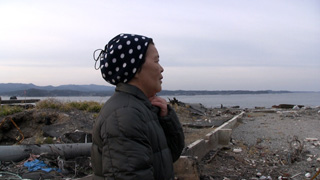Tremorings of Hope
(Negai to yuragi) JAPAN / 2017 / Japanese / Color / Blu-ray / 146 min
JAPAN / 2017 / Japanese / Color / Blu-ray / 146 min
Director, Photography, Editing, Sound, Source: Agatsuma Kazuki
Hadenya, a village in Minamisanriku, Miyagi Prefecture struck on March 11, 2011 by the Great East Japan Earthquake and Tsunami. Following the lives of the people who continue to live in Hadenya after the disaster, this film traces the revival of a traditional lion dance in order to examine the residents’ hopes for reconstruction and the inner turmoil that derives from differences among their stances and thoughts. The director combines images of himself interacting with local people, with shots taken both before and after the disaster, to give a vivid and lively description of the difficult journey towards reconstruction and the many issues that arise along the way. The film picks up where The People Living in Hadenya, screened as part of the “Cinema with Us” program at YIDFF 2013, left off.
[Director’s Statement] On March 12, 2005, I first visited Hadenya, a small fishing village in Minamisanriku Town, Miyagi Prefecture, as I approached the end of my first year at university. And I continued to go there during that period, along with many other fellow students of folklore including my college upperclassmen and our professors. In March 2008 we published a 200-page folklore survey report on life in that fishing village.
For three years during my time as a student I would continue to travel to Hadenya. As I carefully observed the pace of life of this regional society and the work of its people, I began to feel strongly that I wanted to make a film there. While on the one hand the village was swept up in the changing times, it still remained rooted in the land. By closely observing these people’s lifestyle, deeply invested in regional culture, I thought I might take away a more universal lesson about human coexistence.
And so, upon my graduation from university in March 2008, I began documentary production in Hadenya. The 2011 earthquake disaster disrupted this work, and I was no longer able to maintain my composure when training my camera on the village post-disaster. Even so, the questions of what it means to live with the land and to live as a community remained. I know, because I had been watching Hadenya from before the disaster. I think I have managed to express this in the film.
I offer my sincere thanks to the people of Hadenya who were generous enough to welcome me in over the course of twelve years.
 Agatsuma Kazuki
Agatsuma KazukiBorn 1985 in Shiroishi City, Miyagi Prefecture. Agatsuma Kazuki began studying in the Department of History in the Faculty of Letters at Tohoku Gakuin University in 2004. Starting that following March, he participated in folklore studies surveys in Hadenya, Minamisanriku Town, Miyagi Prefecture as part of a cooperative project between the Tohoku History Museum and the Folklore Studies Seminar at Tohoku Gakuin, and he remained active as a leading member. In March 2008, Agatsuma graduated from university and completed a report on fishing village life. Afterward, while working nights in a part-time job to earn a living, he continued his documentary work about Hadenya. Agatsuma was present in the village on March 11, 2011, when the Great East Japan Earthquake and Tsunami struck. He later edited the 240 hours of footage he had recorded in Hadenya over three years into The People Living in Hadenya (YIDFF 2013). After holding screenings on the coast of Miyagi Prefecture in 2014, he then screened the film across Japan. In 2015, Agatsuma founded Miyagi Cinema Cradle, a group that connects filmmakers active in the Miyagi area with citizens from the region. Currently he is editing his second feature-length piece about the disaster’s aftermath, and trying his hand at making a narrative film.
